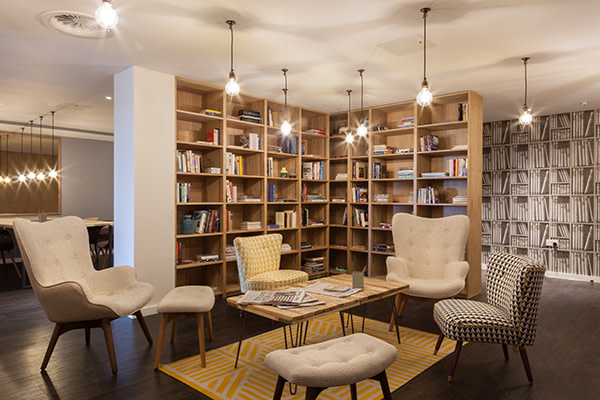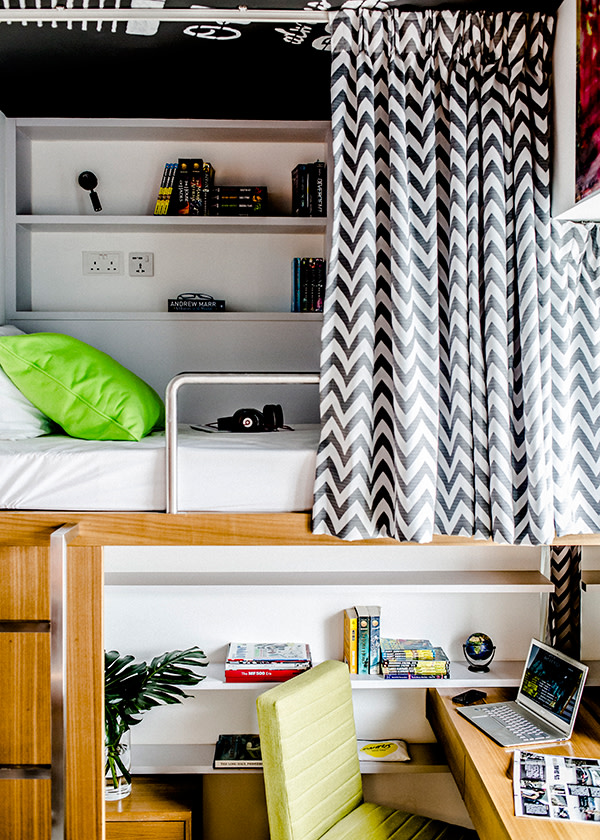Communal living moves upmarket in London, New York and Hong Kong

Simply sign up to the Life & Arts myFT Digest -- delivered directly to your inbox.
Last autumn a recalcitrant WeWork confidant leaked a fundraising pitch used by the company to woo investors.
In five years, the New York-based start-up has created a $16bn business providing shared workspaces to today’s generation of freelancers, start-ups and entrepreneurs. The pitch, written in 2014, suggested that WeWork was plotting to extend its model of creative disruption beyond offices and into homes for today’s Generation Rent. The new venture, called WeLive, was chalked to bring in more than a fifth of the company’s revenue by 2018. The world’s sixth biggest start-up was making a bet of more than half a billion dollars on the future of communal living.
An enterprise more commonly associated with leaky roofs and servings of nut roast seems an unlikely place to mine for property gold. But co-living, where residents trade smaller sleeping areas for large communal spaces and an emphasis on social interaction, is being dug up from its 1970s matted roots and repackaged for affluent millennials.
For its fast-expanding group of acolytes this brave new world of communal kitchens and disco launderettes offers a solution to the dearth of affordable housing for young people in the world’s major cities. It also promises a tonic for the isolation experienced by today’s urban immigrants. And with shorter rental contracts and the advantages of serviced apartments, it caters to the wanderlust of the twenty-something.
Eighteen months after the WeWork leak, and just days before the company launches its first WeLive development, I am gazing out of a newly installed floor-to-ceiling window in Old Oak Common, north-west London. Around me plasterers and electricians are putting the finishing touches to an 11-floor, 550-bed co-living space. From May, it will form the first purpose-built offering by niche developer The Collective to the growing army of London’s affluent, young, renting professionals.
The view to the west is dominated by Park Royal, one of Europe’s largest industrial estates; to the east are the reflective roofs that make up Cargiant, London’s largest used car dealership. It may be 25 minutes from Oxford Circus on the Bakerloo line, but if I had £1,000 per month to spend on rent in my early twenties, I don’t think I’d want to live here — communally or otherwise.

Then I am shown the shared spaces. Each floor contains a themed relaxation area catering to a range of moods and entertainment needs, from library, spa and private cinema to a Japanese tea room. The jewel in the crown is a disco launderette, whose washing machines and tumble dryers (eight of each) will share the space with two disco balls, a sound system and dance area.
A gym, restaurant and bar are almost finished on the ground floor; the floor above will host a co-working space with up to 350 desks, available for non-residents to rent. Communal kitchens on every floor offer impressive dining spaces. This is just as well: the one-bedroom units, which include a galley kitchen, measure 150 sq ft, barely room to swing a saucepan. (Most units have two bedrooms, share a kitchen, and measure 300 sq ft). For a one-bed unit, the monthly rent — ranging from £1,075 to £1,161 — includes every bill, from council tax to WiFi.

The mastermind behind this fantasy college dorm is Reza Merchant, founder of The Collective. The 27-year-old LSE graduate is an engaging London pretender to WeWork’s global co-living ambitions, darting cheerfully from floor to floor of the development on our tour.
He forged the idea in the adversity of his own student days, he says, and his list of gripes with the status quo will be familiar to any young person who has rented in the UK capital. Misleading photographs, agents who never ring back, an interminable wait for utilities and the requirement to fork out thousands of pounds for Ikea furniture that you’ll likely have to throw out or put into storage when you move.
Ninety-seven per cent of the UK’s £1tn-odd residential rental market consists of small-time private landlords, according to Chris Lacey of property adviser CBRE. The majority own a few flats at most, and with few gains to be made by nurturing a good reputation, there is still less incentive to offer a good service. As homebuying moves beyond the reach of many young people, the supply of eager tenants is growing.

Moving in to fill the vacuum is a wave of developers building rental units for today’s affluent young. Merchant’s backer is a private family in Singapore but most are European pension funds and insurance firms, queueing up for the bankable long-term income streams provided by the private rental sector, with which to match the long-term obligations that pensioners and insurance policies demand. Lacey reckons up to £20bn has been committed within the past three years; he predicts another £30bn to £50bn over the next five.
Devoted co-living developments are too niche for most of these investors, who focus on more conventional rental apartment projects. Most of these will be built from scratch: Dan Batterton, who runs the £600m build-to-rent fund at L&G Investment Management wants modern buildings, purpose-built for rental, which can supply at least 150 flats and the chance to create decent-sized communal spaces. He reckons there are about five in the entire UK. “Ten years from now there will be thousands built with money from institutions; they will be purpose-built and properly run,” he says.
What co-living could offer Asia is hard to say. On paper, the rapidly urbanising economies of India and China seem well placed to benefit from the co-living revolution. But few examples yet exist.

“People there are accustomed to smaller spaces,” says Miguel McKelvey, co-founder and chief creative officer of WeWork, but the large numbers of urban migrants detached from their families “haven’t figured out the social model yet”. Strong traditional community ties have been weakened by the rush to big cities; a widespread “feeling of loneliness and isolation,” means that “people are hungry for that social connection”.
In Hong Kong, Peter Pfister, a Swiss hotelier, runs the Campus Hong Kong development in Tsuen Wan, New Territories. He has just finished converting 48 one-bedroom, 660 sq ft apartments into 48 four-bed dormitories, containing individual pods housing a desk and wardrobe under an elevated bunk bed.
Campus charges HK$5,500 ($710) per month for each of the 192 beds, which includes cleaning, bills and WiFi access. There is also a 1,200ft communal space, with a TV area, games consoles and a long desk with power points for studying. Typically, says Pfister, residents stay for four months.

He believes surging student numbers and high land prices will force universities to look increasingly to local providers to accommodate students instead of building new blocks themselves. The local university, he says, must find living spaces for another 3,000 students in the next academic year.
Earlier this month — 18 months after the WeWork leak — WeLive launched its first development spread over 20 floors of a 27-floor high-rise in Wall Street, New York (a second project in Washington DC will soon follow). More than 200 units — from studios to 1,000 sq ft, four-bedroom apartments — are available for rent, each with a private kitchen and at least one bathroom, with prices starting at $1,375 per person (the company does not price the units in their entirety).
The model is certainly convenient. For a monthly management fee of $125, residents receive linen, towels, cable, WiFi and utilities. The fact there are no estate agent fees or credit checks will, no doubt, prove popular with younger flat-hunters. In New York, landlords typically require annual earnings of 40 times the monthly rent, says Chris Bledsoe, who runs a co-living development in Manhattan’s Carmel Place. Beldsoe estimates this puts a typical 500 sq ft Manhattan studio apartment outside the reach of anyone earning less than $100,000 per year.

Yet for McKelvey the real value is in the social and communal offering, provided through a busy programme of events and persistent offers to engage with other WeLivers by communal staff. An only child, he was raised by his mother inside a collective of women and children who shared a variety of houses across New Mexico, California and Oregon. This spawned his conviction in the emotional and social support that a non-family living group can provide.
“The idea is that you look out for each other and that you care for each other. [WeLive] is an environment for figuring out the challenges of life’s path, through a proactive support system,” he says.
It feels like a nebulous premise for a business, let alone one that (if you believe the leaked investor pitch) should be making annual revenues of $606m three years from now. Yet McKelvey is hardly a conventional property developer. And with WeWork’s next round of fundraising expected to raise $780m, there is plenty in the bank to finance some blue-sky thinking.
Photographs: WeLive; Johnny Wolf; The Collective; Mekko Harjo; Monadnock Construction Inc
Comments